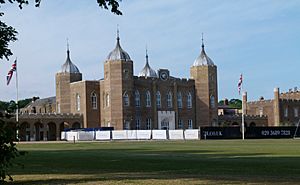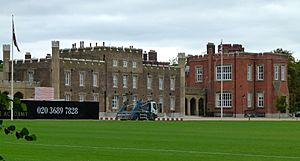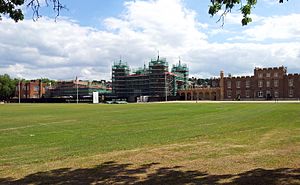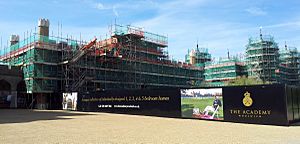Royal Military Academy, Woolwich facts for kids

The New Royal Military Academy, in use 1806 to 1939
|
|
|
Other name
|
"The Shop" |
|---|---|
| Type | Military academy |
| Active | 1741–1939 |
| Affiliation | British Army |
| Location | , |
The Royal Military Academy (RMA) was a special school in Woolwich, London. It trained young people to become officers in the British Army. These officers would lead soldiers in important groups like the Royal Artillery (who use cannons) and the Royal Engineers (who build things). Later, it also trained officers for other technical jobs in the army. People often called the RMA "The Shop." This was because its very first building used to be a workshop at the Royal Arsenal nearby.
Contents
The Story of the Royal Military Academy
How the Academy Started
Back in 1720, a group called the Board of Ordnance tried to start a school. It was meant to train future officers for the Royal Regiment of Artillery and Corps of Royal Engineers. They even started building a new place for it. But money problems stopped the plan.
Finally, the academy opened in 1741. Its goal was to create "good officers of Artillery and perfect Engineers." The students, called 'gentlemen cadets,' were aged 10 to 30. At first, they lived in town. But this caused problems, as they were known for being a bit wild! So, in 1751, a special barracks was built for them. This helped them learn to follow strict military rules.
The school mainly taught maths and science. They learned about how cannons work and how to build defenses. French was also taught. Besides classroom learning, cadets practiced gunnery and building bridges. Civilian teachers taught most subjects. In 1764, the school added 'Military' to its name. It also split into two parts:
- The Lower Academy: For younger cadets, teaching reading, writing, maths, Latin, French, and drawing.
- The Upper Academy: For older cadets, teaching military skills, science, fencing, and dancing.
Moving to a New Home
The academy soon became too big for its first location. So, in 1783, people started thinking about moving it. Architect James Wyatt designed a new set of buildings. They were built between 1796 and 1805. The new academy opened in 1806. It was located on Woolwich Common, facing the Royal Artillery Barracks.
Wyatt's new academy was built in a style called Tudor Gothic. It had a main building in the middle. This building looked a bit like the Tower of London. On each side were buildings where the cadets lived. The main building had classrooms, a library, and offices. The living blocks housed officers and cadets.
128 older cadets moved to the new academy. Younger cadets stayed at the Royal Arsenal or went to a new college in Great Marlow. Practical training still happened at the Arsenal. Over time, cadets (or their parents) had to pay fees to attend. This made the academy feel more like a private school.
In 1844, the academy had about 130 young gentlemen. They learned maths, surveying, map-making, fortification, and engineering. They also practiced using muskets, swords, and small cannons. The school was led by a lieutenant-general and had professors for maths and fortification.
After the Crimean War, the academy changed again. The youngest age for cadets became fifteen. More special training was added. The academy buildings were made bigger in the 1860s. New classrooms and living areas were added. Sports fields and gun batteries for training were also built. In 1873, the main building had to be rebuilt after a big fire.
Gallery of the Academy Buildings
The Academy Closes
For a long time, people thought about combining the Royal Military Academy with another army school, the Royal Military College, Sandhurst. This idea became stronger in the 1920s. In 1936, it was decided to merge them. But then World War II started in 1939. Both schools closed as their cadets went to fight in the war.
The Royal Military Academy Woolwich closed for good in 1939. In 1947, the Royal Military Academy Sandhurst was created. It became the main place to train all army officers.
After closing, the old Woolwich academy site was used by different army groups. The main building became home to a museum and offices. The chapel became the main church for the army base. The academy continued to be used by the military for many years. But in 2002, the army decided they didn't need the site anymore. It closed in 2003. Some beautiful stained glass windows from the chapel were moved to another church.
What Happened to the Site
A company called Durkan Group bought the Woolwich site in 2006. They started turning the old buildings into homes in 2008. Many of the buildings are special and protected because of their history. They were changed into 334 houses and apartments. Some of these homes were for a housing association. By 2017, the main buildings were almost fully renovated. The old cricket field at the academy is still used today by a local cricket club.
What the Academy Left Behind
How it Changed Training
Before 1870, most officers in the British Army bought their positions. Training wasn't seen as a must-have. But the Royal Military Academy was different. It made training and education necessary for officers. And promotion was based on how well you did in exams, not how much money you had.
Famous Buildings
The main buildings of the academy are very important. Experts say they are "an outstanding example" of the Gothic style and "one of the most important pieces of military architecture in the country."
Everyday Words from the Academy
Some everyday phrases might have come from the academy:
- "Talking shop" means discussing things that others don't understand.
- The game "snooker" is said to have been invented by a former cadet. The name might come from a slang term for new cadets, "snooks."
Notable Teachers
Many smart people taught at Woolwich. Here are a few:
- Peter Barlow, a maths teacher from 1801 to 1847.
- Michael Faraday, a famous chemist who taught from 1829 to 1852.
- Charles Hutton, a maths professor from 1773 to 1807.
- Paul Sandby, the chief drawing teacher from 1768 to 1799.
- James Joseph Sylvester, a maths professor from 1855 to 1870.
Images for kids
See also
- Category:Graduates of the Royal Military Academy, Woolwich
Sources
(Second, revised edition; online edition at Harvard here)


















